Conservative Enthusiasm for Bernie Sanders Suggests He Can Unite a Divided Public
I spent days with fans of presidential candidate Sanders across red states. They watch Fox News, live in the heartland, and are voting for Bernie.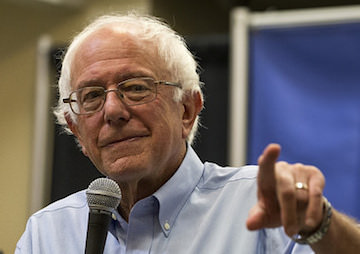
By Rick Perlstein, The Washington Spectator
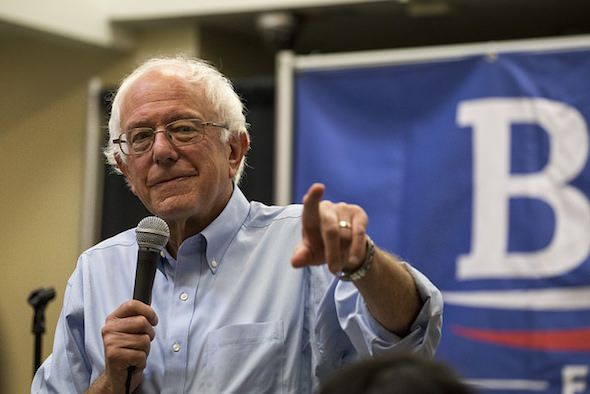
“… What my job is, and it’s not just in blue states … [is] to bring working people together around an economic agenda that works,” Sen. Bernie Sanders said while campaigning in August. (Phil Roeder / CC BY 2.0)
This piece first appeared at The Washington Spectator.
Nate Silver has the Bernie Sanders campaign figured out. Ignore what happens in Iowa and New Hampshire, the “data-driven” prognostication wizard wrote back in July, when Sanders was polling a healthy 30 percent to Clinton’s 46 percent in both contests. That’s only, Silver says, because “Democratic caucus-goers in Iowa and Democratic primary voters in New Hampshire are liberal and white, and that’s the core of Sanders’ support.”
Silver has a chart. It shows that when you multiply the number of liberals and whites among state electorates, Vermont, New Hampshire, and Iowa rank first, second, and third. Texas is near the bottom—a place where Bernie Sanders should feel about as welcome as a La Raza convention at the Alamo, right?
I have a new friend who begs to differ.
It’s July 20, and my airplane seat mate asks what brought me to Texas. He is a construction company sales executive from Houston. He’s watching Fox News on his cell phone. He tells me he considers himself a conservative. I tell him I’m a political reporter covering the Bernie Sanders campaign. He perks up: “I like what I’ve heard from him. Kind of middle of the road.”
Eleven days later, I’m at a Bernie Sanders house party in the depressed steel town of Griffith, Indiana, in a state that places in the bottom quartile on Silver’s chart. I approach a young man in his twenties wearing a thrift store T-shirt. I ask him what brings him here tonight.
“I’m just helping out my friends because they asked me to help out,” he tells me. He adds that he’s a conservative: “But I approve of some of the stuff that Bernie stands for. Like appealing to more than just the one percent and just trying to give everybody a leg up who’s needing it these days.” Data-driven analysis is only as good as the categories by which you sift the information. If you’ve already decided that “liberals” are the people who prefer locally sourced arugula to eating at McDonald’s, or are the people who don’t watch Fox News, it is a reasonable conclusion that there aren’t enough “liberals” out there to elect Bernie Sanders. Yet political categories shift. One of the things the best politicians do is work to shift them.
Sanders has been extraordinarily clear about the kind of shift he’d like to effect: Republicans “divide people on gay marriage. They divide people on abortion. They divide people on immigration. And what my job is, and it’s not just in blue states. . . [is] to bring working people together around an economic agenda that works. People are sick and tired of establishment politics; they are sick and tired of a politics in which candidates continue to represent the rich and the powerful.”
The theory that economic populism unites voters is hardly new. Lyndon Johnson, in New Orleans and about to lose the South to Barry Goldwater in 1964, expressed it in one of the most remarkable campaign speeches in history. A Southern Democratic politician was on his deathbed, Johnson said. “He was talking about the economy and what a great future we could have in the South, if we could just meet our economic problems. . . ‘I would like to go back down there and make them one more Democratic speech. I just feel like I have one in me. The poor old state, they haven’t heard a Democratic speech in 30 years. All they ever hear at election time is nigger! nigger! nigger!’”
The theory suggests that when upwards of 60 percent of voters consistently agree that rich people should have their taxes raised, a candidate who promises to do so might be identified as what he actually is: middle of the road. That if Democrats give Democratic speeches on economic issues, voters suckered into Republicanism by refrains like Jihad! Jihad! Jihad! just might try something else. And that new voters might be attracted into politics if they could just hear a candidate cut to the radical quick of the actual problems that are ruining their lives. My new Republican friends didn’t know they were not “supposed” to like a “liberal” like Bernie Sanders. Then they heard what he was saying, and liked what they heard. How many are there like them? That’s what I’ve been trying to begin to find out.
A populist moment in Dallas
Dallas is Dallas. At Love Field, a middle-aged woman sports a “Mrs.” T-shirt—1970s-style antifeminist trolling. I pass the Dallas Country Club, which made news last year for admitting its first black member after he spent 13 years on a waiting list. The Holocaust Museum features a “Ground Zero 360: Never Forget” exhibit on 9/11. (Jihad! Jihad! Jihad!)
Hillary Clinton had recently been to Texas. She did a fundraiser here in a gated community where guests were told the address only after delivering their $2,700 checks. For nationally prominent Democrats, one of the donors complained, “All Texas is to anyone is a stop to pick up money.”
Not all nationally prominent Democrats. When I talk with a bunch of old hippies after an afternoon Sanders rally at a downtown convention center in Dallas, their minds are blown. Long-haired Zen Biasco is a professional “creativity teacher”; Morris Fried first picketed against apartheid in 1965. The only non-Jew in the group, and the only native Southerner, explains Texas politics: “The states that came up throughout the plantation economy did not really believe” in democracy. “It was the elites running things, and basically the GOP here in the South, especially in Texas, has inherited that basis of understanding. In Texas we are not necessarily a red state. We are a non-voting state.”
These are the people you’d see at any lefty rally anywhere. But this lefty rally was unlike any they’ve seen in their adopted hometown. “I’m shocked at such a draw on a Sunday afternoon!” one offers. “I’m shocked at all the young people in this crowd!”
Before Sanders began speaking, I had spoken to two of those young people, a married couple, who represent a liberal holy grail: kids who had grown up conservative—Mormons!—and reasoned their way to the left. “Thanks to people like Bernie,” as one put it. They try to spread the gospel to professional circles saturated with Republicans and to their families back home.
The husband unspools a splendid version of the Sanders argument:
“I don’t think the values of those communities are really represented in their politics, family values, the ideology they profess to have. . . doesn’t match up with the words or things [the politicians they align themselves with] actually represent. I don’t think people realize that if they actually were for family values, and were for the working family, that Republican policies are not going to move you closer.”
Sanders on the stump
The speech begins. I’ve rarely heard one more electric. Bernie gets to the part about how America could increase its competitiveness and move toward full employment by spending a trillion dollars rebuilding bridges and roads, and a fashionably dressed young woman next to me with a swallow tattoo on her wrist cries out like a cheerleader.
“INNNNNNNFRASTRUCTURE!!!!”
The senator follows with a disquisition about the Sherman Act.
“ANTI-TRUSSSSTTT!” she shouts.
When he gets to reinstating the Glass-Steagell act, she lets out a “WHOOOOOOOO!”
At the 21-minute mark comes something extraordinary. After a reverberating ovation for a call for pay equity for women, a promise to fight for 12 weeks of paid family leave, and an excoriation of the fact that “the American people work more hours than any other major country on Earth.” Then the senator announces his marquee platform plank.
“To make every public college and university tuition-free.”
The crowd’s response is so ecstatic it overdrives my tape recorder. It continues into a chant: “BERNIE! BERNIE! BERNIE! BERNIE!”
And when the show ends, a crowd in a nearly post-coital mood of sated exhilaration doesn’t want to leave, doesn’t leave, until Bernie returns to to the podium for something I’ve never witnessed at a political event, an encore, and announces that the crowd numbered 6,000.
I followed the campaign that evening to the University of Houston, where he got the same thunderous reception before 5,200 college students. Both events got prominent play in the local media, where hundreds of thousands of Texans heard heretical ideas that they might not have read in their newspapers before: like raising taxes on the rich isn’t crazy, even if 62 percent of Americans agree.
Some things polls have a hard time recording. They may miss kids like these, who only carry cell phones, as pollsters rely mostly on landlines. Or the intensity of support, how many people are willing to knock on doors for a candidate. And, last but very much not least, novel issues and how constituencies respond to them.
In 1965, for instance, when he began running for governor, Ronald Reagan made the focal point of his speeches the student uprising at Berkeley. His consultants told him to knock it off because it wasn’t showing up in their polls as a public concern. Reagan ignored them, reading the response of crowds that didn’t yet think that students tearing up their college campuses was a “political issue” to bring up when pollsters called.
Similarly, in the late 1970s, when the Equal Rights Amendment began failing in state after state though polls showed it had majority support, a sociologist named Ruth Murray Brown polled anti-ERA women activists in North Carolina and found that more than half of them had never participated in politics before. The pundits didn’t know how to count what they didn’t know was out there.
Rust belt populism
That’s what I thought of when I met Gypsy and David Milenic, whose front lawn had hosted that house party on July 30. I had read an interview with Sanders in which he said the campaign was hosting these parties around the country, which he would address via a live video feed. I chose one as far afield as possible from the places where “liberals” are supposed to congregate. Ten miles past a creationist museum billboard on I-90, there was no arugula, but there were crackers, pretzels, and store-bought gingersnaps. Griffith, Indiana, population 16,619, has a per capita income of $21,866.
“My history of political volunteering is that this is the first political volunteering I have done,” Gypsy tells me, taking a break from directing traffic and packing her two small children off to grandma’s. “But, to be honest, Bernie is the first person who’s gotten me out of my chair and out doing things.”
From her front porch, she casts her nervous eye over a lawn that keeps filling, and filling, and filling. (In the interview Sanders said the campaign was planning for 30,000 participants across the nation; the final number turned out to be 100,000.)
“This home was paid for by union dues,” Gypsy says. “That matters. Keeping it in the family: that matters. Being able to have a small town like this that was a mix of blue-collar and white-collar matters.”
At 6:30 a political meeting unfolds unlike any I have ever seen. Bernie is to speak on a live feed at 8:00. David, an accountant, welcomes us, and invites people to stand up and introduce themselves.
A young man who has been busily setting up the AV system volunteers to go first.
“Both my parents together made barely over the poverty line, and I can tell you that life sucks,” he begins.
“I have no financial support from my family. I get very little from the government. I am on my own, trying to make it, trying to thrive, just like everybody behind me. And it’s hard. And I am currently about 50 grand in debt between student loans, car loans. . . and I am trying so damned hard. And working so damned hard.”
The crowd responds with an ovation.
“I see all my friends, and all of my friends who suffer the same way I do, and they can’t make ends meet. They work three jobs. . . and they still struggle! And it just burns me. Because it wasn’t like this! Now, you go to college for four years and you’re in debt 20, 30 years. Sometimes for life. . .”
He trails off. Applause encourages him on. “I want to see change. And I believe Bernie Sanders is the one to do it.”
And on it went. For an hour and a half, testimony after testimony after testimony. The issue of student debt dominated. So did the consensus that together they could do something about it.
In Griffith, I met a remarkable black retiree named Martha Harris. Her grandparents were slaves, and she remembers going into hiding at the age of three when her father was run off by the Klan for being “uppity.” She had been following the story of Sanders’s public encounters with Black Life Matters activists at the Netroots Nation gathering in Phoenix. She just wondered why people were still going on about it. “I saw him flub. And like any white man, his staff put him out there without his underwear on. So he ran home and he got his long johns on. And I’m okay with that. He’s learning.”
Harris was one of the Sanders supporters who, following that evening in Griffith, set up a storefront Sanders office in Hammond, Indiana. She had recently been a guest on a radio show in Gary, where the African-American population is 85 percent and one third of the houses are abandoned. She was scheduled for a half hour. The response was so enthusiastic the interview went on for an hour and a half.
Among the political class, the discussion of the supposed reverberations that followed Sanders’s encounter with Black Lives Matter activists in Phoenix was incessant. That kind of conflict is something the political media knows how to talk about. So they talk about it. What happened on the radio in Gary, not so much.
Responsive politics
The question is, what else is happening that they aren’t talking about?
Maybe this. In 2005, MSNBC’s Chris Hayes published some remarkable journalism on his experience canvassing for John Kerry in Wisconsin, where voters didn’t seem to have any idea that their economic distress was something for which voting could make a difference.
“When I would tell them that Kerry had a plan to lower health-care premiums, they would respond in disbelief—not in disbelief that he had a plan, but that the cost of health care was a political issue,” Hayes reported. “It was as if you were telling them that Kerry was promising to extend summer into December.”
Hayes wondered what a more responsive Democratic politics would look like.
“One thing that nearly all Americans share is debt.” His idea? “Building a movement around credit reform—through the formation of local ‘debt clubs’ that would be part of a national campaign, for example—would be one way for progressives to reach out to non-believers.”
Now “debt clubs” are being formed. They’re being formed around the Sanders campaign. I wouldn’t argue that this will add up to a presidential nomination. But I’ve seen enough in places like Dallas, Houston, and on David and Gypsy Milenic’s front lawn in Griffith to know that something is happening here, something that reminds us that our existing models for predicting winners and losers in politics need always be subject to revision.
Rick Perlstein is The Washington Spectator’s national correspondent. This piece first appeared at The Washington Spectator.
Independent journalism is under threat and overshadowed by heavily funded mainstream media.
You can help level the playing field. Become a member.
Your tax-deductible contribution keeps us digging beneath the headlines to give you thought-provoking, investigative reporting and analysis that unearths what's really happening- without compromise.
Give today to support our courageous, independent journalists.

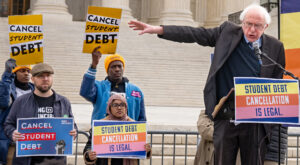


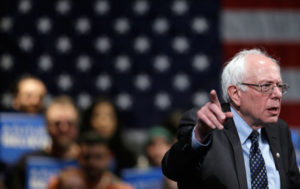
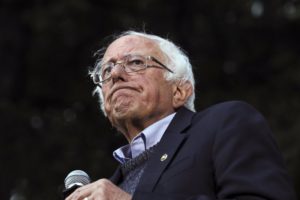
You need to be a supporter to comment.
There are currently no responses to this article.
Be the first to respond.